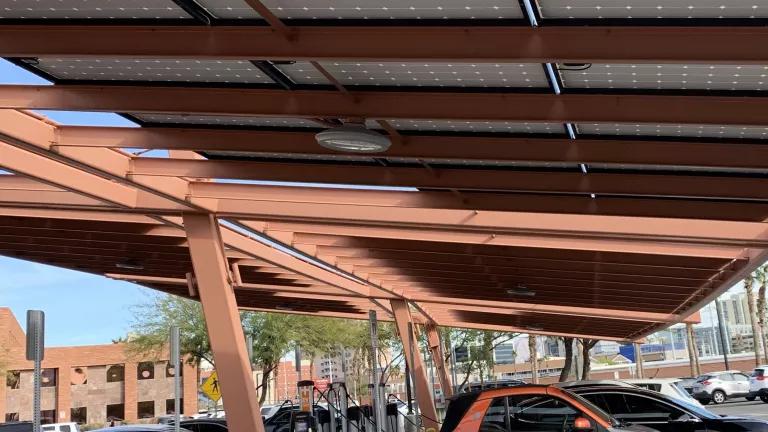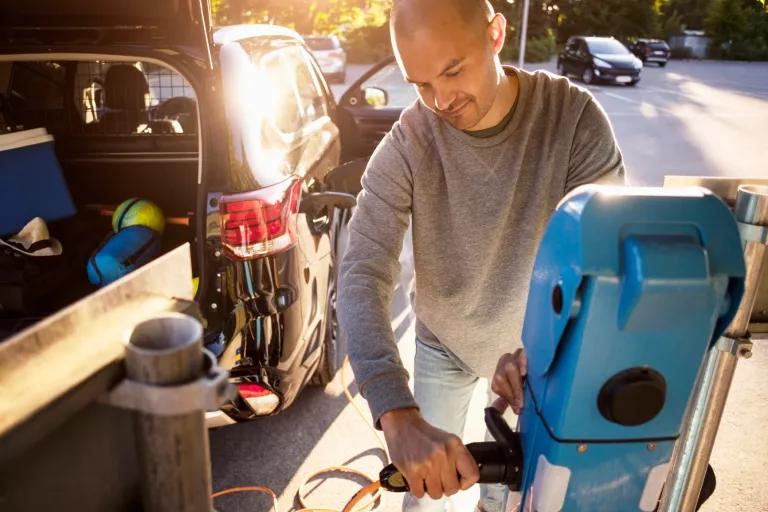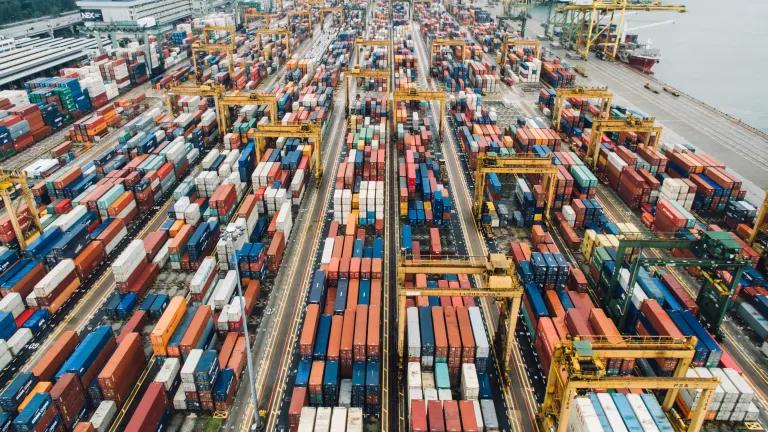Nevada Accelerates on Clean Cars
Governor Sisolak’s administration took a vital step today to reduce climate-warming and health-harming pollution from cars and trucks: initiating a Clean Cars rulemaking.

With the ZEV program, this solar-plus-charging setup, as seen in Vegas, would be an option for a lot more Nevadans.
Governor Sisolak’s administration took a vital step today to reduce climate-warming and health-harming pollution from cars and trucks: initiating a Clean Cars rulemaking. If implemented, the Clean Car Standards would protect Nevadans’ health, expand their transportation options, save them money at the pump and on electric bills, and conserve their beautiful natural environment. The move was widely hailed by consumer interest groups, public health advocates, local governments, organized labor, environmental justice and social equity organizations, business leaders, and a host of environmental and conservation organizations. This forms part of the Sisolak administration’s efforts to get Nevada back to business in this extraordinarily difficult time and to find ways to help grow the economy while protecting public health.
This latest move builds on ever growing clean transportation and climate momentum in Nevada. From creating the Nevada Electric Highway to joining the Nation’s Clean Car Promise, Nevada has been working for years to protect the climate and help more Nevadans drive electric. In November, Governor Sisolak reaffirmed his commitment to tackle transportation emissions by saying that he was “excited to announce that Nevada will stand with other leading states and begin moving towards stronger vehicle emission standards.”
How Clean Car Standards Work
The Clean Car Standards improve air quality by reducing smog-forming pollution and greenhouse gas emissions from light-duty passenger vehicles through the low-emission vehicle (LEV) and the zero-emission vehicle (ZEV) programs. If adopted, Nevada will join 14 other clean car states that have adopted LEV, which represent 36 percent of the U.S. car-buying market, and will be the second Clean Car state in the Interior West. (Colorado adopted its own Clean Cars program last year.) Minnesota, New Mexico, Washington—and now, Nevada—are considering or have started the process of adopting these standards in the face of dangerous rollbacks from D.C.
If adopted by DCNR, the standards will reduce pollution and ensure automakers are introducing more models of new, advanced electric vehicles to the state, such that about 6 to 8 percent of vehicles delivered to Nevada in 2025 will have the ability to plug-in and run on electricity.
Clean Cars Are Good News for Nevada’s Climate and Air
The transportation sector is responsible for the greatest share of greenhouse gas emissions in the state, according to the Nevada Division of Environmental Protection (NDEP) inventory. It is also a leading source of the air pollutants that create smog, which is linked to respiratory diseases like asthma. The Las Vegas-Henderson metro area is the 9th most polluted in the country for ozone—also known as smog—and the 25th most polluted for particulate matter.
The interconnected problems of air pollution and public health can have far-reaching consequences. A 2010 study of the Clark County School District found that students with asthma were far more likely to miss school and that these absences can have long-term negative impacts on their learning. And preliminary studies indicate that more polluted air contributes to higher COVID-19 death rates, which underscores the importance of clean air policies to public health and resilience.
The transportation sector is also projected to be the state’s largest source of climate-warming pollution for at least the next two decades, as modeled in the NDEP greenhouse gas inventory. Northern and Southern Nevada both are already seeing the impacts of climate change in the ongoing megadrought across the Southwest and in increased temperatures. That warming compounds existing public health problems such as heat stress, heat-related deaths, and cardiovascular disease. (You can read more about existing climate change impacts in Nevada here.) Higher temperatures also contribute to the formation of smog, making an existing smog problem even worse.
The state needs to move forward with policies such as the Clean Car Standards to reduce harmful transportation emissions and meet the greenhouse emissions reduction targets established in SB 254 and Governor Sisolak’s climate-focused Executive Order last year.
What Clean Cars Means for Nevadans

Beyond the environmental and public health benefits of cleaner air and reduced carbon pollution, the Clean Car Standards are poised to bring significant economic and consumer benefits to Nevada.
As the state starts planning for economic recovery, there is significant potential to build on the existing foundations of Nevada’s clean transportation and clean energy sectors. In 2019, the clean transportation industry employed 1,300 people in the Silver State, according to that year’s E2 Clean Jobs Nevada report. A study from the Southwest Energy Efficiency Project (SWEEP) found that bringing more electric cars to the state through programs like ZEV could create approximately 2,200 to 6,150 new jobs in 2030, depending on how quickly the state’s electric vehicle market grows. Adopting the Clean Car Standards would also send a signal to automakers and the electric transportation industry that Nevada is a smart investment. Overall, this program would be a significant way to help create jobs and diversify the economy long term.
Putting more electric cars on the road will also save Nevadans money. Electric car drivers save money because electric cars have much lower maintenance costs and it’s cheaper to fuel a car with electricity than with gasoline. In Vegas, driving on electricity is the cost-equivalent of driving on $0.93 per gallon gasoline. And on the right utility rate plan, electricity would cost as little as $0.41 per gallon. Additionally, higher rates of electric car adoption have been shown to lower electric bills for all customers, regardless of the kind of car they drive, because they spread the fixed cost of maintaining the electric system over more total sales.
Reaping all these benefits depend on the availability of electric cars in Nevada. Unfortunately, out of over 40 electric and plug-in hybrid car models that exist today, automakers have made only a dozen plug-in models available for sale at dealerships in the Reno and Vegas metro areas, based on NRDC’s June 2019 analysis of vehicle availability data in those cities. According to an NRDC analysis of data from Kantar Media, in 2018, there was almost no advertising or marketing for electric cars in the state, which further limits public awareness. Fortunately, states that have adopted the ZEV policy have seen far more electric cars available for sale at their dealerships, which further increases consumer choice and awareness.
What’s Next
Nevadans will be able to stand up to support Clean Car Standards during the rulemaking process. The Department of Conservation and Natural Resources will be considering the public’s input on how Clean Car Standards can best meet their needs and how to design a program that works for Nevada. This is a significant step in cleaning up the transportation sector and we look forward to seeing the Sisolak administration’s continued leadership on climate and public health.



